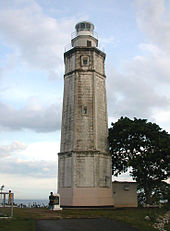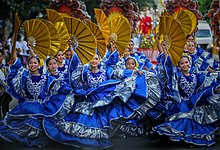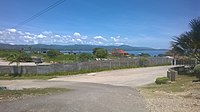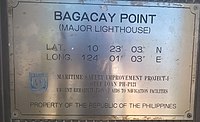Liloan
 From Wikipedia - Reading time: 14 min
From Wikipedia - Reading time: 14 min
Liloan | |
|---|---|
| Municipality of Liloan | |
 From Suba bridge | |
| Etymology: Cebuano term lilo, meaning whirlpool | |
 Map of Cebu with Liloan highlighted | |
Location within the Philippines | |
| Coordinates: 10°24′40″N 123°58′56″E / 10.41111°N 123.98222°E | |
| Country | Philippines |
| Region | Central Visayas |
| Province | Cebu |
| District | 5th district |
| Founded | 1845 |
| Barangays | 14 (see Barangays) |
| Government | |
| • Type | Sangguniang Bayan |
| • Mayor | Aljew Fernando J. Frasco |
| • Vice Mayor | Darwin T. Apas |
| • Representative | Vincent Franco D. Frasco |
| • Municipal Council | Members |
| • Electorate | 82,428 voters (2022) |
| Area | |
• Total | 45.92 km2 (17.73 sq mi) |
| Elevation | 20 m (70 ft) |
| Highest elevation | 231 m (758 ft) |
| Lowest elevation | 0 m (0 ft) |
| Population (2020 census)[3] | |
• Total | 153,197 |
| • Density | 3,300/km2 (8,600/sq mi) |
| • Households | 37,390 |
| Economy | |
| • Income class | 1st municipal income class |
| • Poverty incidence | 18.81 |
| • Revenue | ₱ 369.4 million (2020), 157.5 million (2012), 168.3 million (2013), 193.4 million (2014), 217.6 million (2015), 244.2 million (2016), 284.7 million (2017), 317.8 million (2018), 336.6 million (2019), 560.1 million (2021), 641.4 million (2022) |
| • Assets | ₱ 829.7 million (2020), 380.6 million (2012), 407.6 million (2013), 467.5 million (2014), 580.7 million (2015), 657.6 million (2016), 750.9 million (2017), 836.5 million (2018), 884.6 million (2019), 924.2 million (2021), 1,320 million (2022) |
| • Expenditure | ₱ 515.1 million (2020), 136.5 million (2012), 136.6 million (2013), 147.7 million (2014), 180.4 million (2015), 193.6 million (2016), 202.8 million (2017), 242.6 million (2018), 317.6 million (2019), 386.7 million (2021), 560.6 million (2022) |
| • Liabilities | ₱ 374.9 million (2020), 175.3 million (2012), 182.3 million (2013), 21.16 million (2014), 289.8 million (2015), 296.3 million (2016), 316 million (2017), 312 million (2018), 342 million (2019), 263.6 million (2021), 576.1 million (2022) |
| Service provider | |
| • Electricity | Visayan Electric Company (VECO) |
| Time zone | UTC+8 (PST) |
| ZIP code | 6002 |
| PSGC | |
| IDD : area code | +63 (0)32 |
| Native languages | Cebuano Tagalog |
| Website | www |
Liloan, officially the Municipality of Liloan (Cebuano: Lungsod sa Liloan; Tagalog: Bayan ng Liloan), is a 1st class municipality in the province of Cebu, Philippines. According to the 2020 census, it has a population of 153,197 people making it the most populated municipality in Visayas and in Cebu Province.[3] Liloan lies within Metro Cebu.
Liloan is bordered on the north by the town of Compostela, to the west by Cebu City, on the east by the Camotes Sea, and on the south by the town of Consolacion. It is 18 kilometres (11 mi) from Cebu City.
History
[edit]Along its coastline, there is a spot called Silot, where a whirlpool is created by the ebbs and flows of the waters from the bay. This phenomenon is called lilo in Cebuano. Because of this, the town was known as Liloan, meaning "a place where there is a lilo".
Sometime in the 1970s, a newspaper article stated that the "pueblo de Lilo‑an" was separated from the municipality of Mandaue (now Mandaue City), and was created a new municipality in 1840. However, in his "Breve reseña de lo que fue y de lo que es la Diócesis de Cebú en las Islas Filipinas," Redondo (1886) states that Lilo‑ a was created as a parish in 1845 (in 1995, Lilo‑ a celebrated its sesquicentennial - 150th – anniversary.)
The creation of the municipality of Lilo‑an could have been at the same time the parish was established, but not earlier than its being a parish. As recorded, the first priest of Lilo‑ served in 1845. The term of the first mayor was from 1845 to 1846.
During the war years (World War II), Lilo‑an had three mayors at one time.
Geography
[edit]Barangays
[edit]Liloan is politically subdivided into 14 barangays. Each barangay consists of puroks and some have sitios.
| PSGC | Barangay | Population | ±% p.a. | |||
|---|---|---|---|---|---|---|
| 2020[3] | 2010[5] | |||||
| 072227001 | Cabadiangan | 1.3% | 1,982 | 1,790 | 1.02% | |
| 072227002 | Calero | 3.5% | 5,315 | 4,513 | 1.65% | |
| 072227003 | Catarman | 10.3% | 15,829 | 14,839 | 0.65% | |
| 072227004 | Cotcot | 4.4% | 6,796 | 5,185 | 2.74% | |
| 072227005 | Jubay | 7.8% | 11,931 | 8,819 | 3.07% | |
| 072227006 | Lataban | 1.5% | 2,245 | 1,863 | 1.88% | |
| 072227007 | Mulao | 0.7% | 1,067 | 952 | 1.15% | |
| 072227008 | Poblacion | 9.8% | 15,041 | 13,371 | 1.18% | |
| 072227009 | San Roque | 1.0% | 1,521 | 1,331 | 1.34% | |
| 072227010 | San Vicente | 6.7% | 10,219 | 8,665 | 1.66% | |
| 072227011 | Santa Cruz | 1.4% | 2,203 | 1,899 | 1.50% | |
| 072227012 | Tabla | 0.9% | 1,423 | 1,189 | 1.81% | |
| 072227013 | Tayud | 10.3% | 15,814 | 13,616 | 1.51% | |
| 072227014 | Yati | 17.9% | 27,367 | 22,468 | 1.99% | |
| Total | 153,197 | 100,500 | 4.30% | |||
Climate
[edit]| Climate data for Liloan, Cebu | |||||||||||||
|---|---|---|---|---|---|---|---|---|---|---|---|---|---|
| Month | Jan | Feb | Mar | Apr | May | Jun | Jul | Aug | Sep | Oct | Nov | Dec | Year |
| Mean daily maximum °C (°F) | 28 (82) |
29 (84) |
30 (86) |
31 (88) |
31 (88) |
30 (86) |
30 (86) |
30 (86) |
30 (86) |
29 (84) |
29 (84) |
28 (82) |
30 (85) |
| Mean daily minimum °C (°F) | 23 (73) |
23 (73) |
23 (73) |
24 (75) |
25 (77) |
25 (77) |
25 (77) |
25 (77) |
25 (77) |
25 (77) |
24 (75) |
23 (73) |
24 (75) |
| Average precipitation mm (inches) | 70 (2.8) |
49 (1.9) |
62 (2.4) |
78 (3.1) |
138 (5.4) |
201 (7.9) |
192 (7.6) |
185 (7.3) |
192 (7.6) |
205 (8.1) |
156 (6.1) |
111 (4.4) |
1,639 (64.6) |
| Average rainy days | 13.4 | 10.6 | 13.1 | 14.5 | 24.2 | 27.9 | 28.4 | 27.7 | 27.1 | 27.4 | 22.5 | 15.9 | 252.7 |
| Source: Meteoblue[6] | |||||||||||||
Demographics
[edit]| Year | Pop. | ±% p.a. |
|---|---|---|
| 1903 | 10,024 | — |
| 1918 | 19,842 | +4.66% |
| 1939 | 13,662 | −1.76% |
| 1948 | 12,292 | −1.17% |
| 1960 | 16,424 | +2.44% |
| 1970 | 22,495 | +3.19% |
| 1975 | 26,492 | +3.33% |
| 1980 | 30,196 | +2.65% |
| 1990 | 42,587 | +3.50% |
| 1995 | 50,973 | +3.43% |
| 2000 | 64,970 | +5.34% |
| 2007 | 92,606 | +5.01% |
| 2010 | 100,500 | +3.02% |
| 2015 | 118,753 | +3.23% |
| 2020 | 153,197 | +5.14% |
| Source: Philippine Statistics Authority[7][5][8][9] | ||
Economy
[edit]Poverty incidence of Liloan
5
10
15
20
25
30
2006
22.00 2009
17.95 2012
10.54 2015
14.66 2018
7.20 2021
18.81 Source: Philippine Statistics Authority[10][11][12][13][14][15][16][17] |
Landmarks
[edit]
Lighthouse
[edit]One of the best known landmarks in Lilo‑an is its historic lighthouse at Bagacay Point. The original lighthouse was built in 1857 by the Spanish. The current tower was constructed in 1904 by order of William Howard Taft,[18] the first Governor-General of the Philippines and later the President of the United States. The tower is 22 metres (72 ft) tall and remains in active use today, using solar energy.[19] The lighthouse was declared a National Historical Landmark in 2004 by the National Historical Commission of the Philippines (formerly known as National Historical Institute).[20]
Liloan Church (San Fernando Rey Parish Church)
[edit]
The designer of the church in Liloan is viewed by some as visionary. Despite Liloan having only 5,000 citizens, when the church was constructed in 1847, this local church was even larger than that of Mandaue, Cebu's second largest city.
Pier 88

Pier 88 is a noteworthy maritime terminal situated in the coastal town of Liloan, in the province of Cebu, Philippines. As a gateway connecting the islands of the Central Visayas region: Camotes, LapuLapu city, Cebu City, it plays a vital role in facilitating transport, commerce, and tourism. The Pier was officially inaugurated and opened to the public on May 27, 2023 by Bongbong Marcos. [21] 3d scan of the site was made by private company Data Ops Philippines on the 28-05-2023[22]
Titay's Rosquillos and Delicacies
[edit]

The making of these little ringlet cookies dates back to 1907, when 21-year-old Margarita Corazon "Titay" Frasco (single, unmarried) was tinkering in her kitchen with her baking ingredients and made her new culinary creation. Kneading the dough manually and using a wooden eggbeater, some baking tins and a clay oven, she started a product that would put her little town in the national and international map of gastronomic delight. Corazon “Mama Azon” Frasco took over in 1999, succeeded by Gerardo and Panfil Frasco, the third generation.
The market for her unnamed cookie started with her neighbors and passers-by who were offered the snack with a bottle of soda. It was Sergio Osmeña (then Cebu governor, who later became Philippine president), who gave it the name "Rosquillo" after the Spanish word rosca.
The “premium heritage brand” biscuits have been a regular stopover of tourists and locals travelling north of Cebu. The company has withstood the taste of time. It started with just rosquillos and tablea making.[a] It later expanded to an array of homemade delicacies including torta, mamon, monay, otap, CPA (chicken pork adobo), bao-bao , galletas (Bato), galletas (Carmen) and hojaldres.
In 2012, its two-hectare plant in Liloan produces about 3,000 packs of 180 grams Rosquillos daily by 118 workers.[23][24]
In 2013, the flagship store which produces 360,000 rosquillos a day was transformed into a café for 45 customers serving penato (peanuts), banana chips and binangkal, among others.[25]
On April 1, 2024, Christina Frasco with members of her family and Margarita “Margo” Domingo Frasco, Chief operating officer led the groundbreaking of its Poblacion, Liloan 1.3-hectare new factory which will employ to 250 workers. We "assure Titay's future without sacrificing livelihood,” said Vincent Franco D. Frasco, Titay's Finance Director.[26]
Tourism
[edit]Rosquillos Festival
[edit]Celebrated every last week of May in honor of the town's patron saint, St. Ferdinand III. It celebrates the Rosquillos as the delicacy of Liloan and of Cebu. The 12th Rosquillos festival was held in May 26,2019. The 13th returned from May 20-30, 2023, coinciding with the 176th annual foundation fiesta celebration.[27][28][29]

List of heads of local government
[edit]- Basilio Bantilan (1845 - 1846)
- Hipolito Pepito (1846 - 1847)
- Francisco Cabahug (1847 - 1848 and 1859 - 1860)
- Esteban Cañete (1848 - 1849, 1850 - 1851 and 1852 - 1853)
- Juan Delgado (1849 - 1850)
- Juan Cabatingan (1851 - 1852 and 1861 - 1862)
- Cruz Mendoza (1853 - 1855 and 1860 - 1861)
- Alberto Yungco (1855 - 1857)
- Victor Pepito (1857 - 1858, 1863 - 1865 and 1875 - 1879)
- Pedro Pepito (1858 - 1859 and 1862 - 1863)
- Felix Cabatingan (1865 - 1867)
- Jacinto Cañete (1867 - 1869)
- Apolonio Pilapil (1869 - 1871)
- Custodio Mendoza (1871 - 1873, 1883 - 1885 and 1899 - 1900)
- Guillermo Pepito (1873 - 1875)
- Ambrosio Pepito (1879 - 1881)
- Eugenio Pilapil (1881 - 1883 and 1889 - 1891)
- Mamerto Cabatingan (1883 - 1887 and 1891 - 1893)
- Sotero Cabatingan (1887 - 1889, 1900 - 1902 and 1905 - 1909)
- Antonio Villamor (1893 - 1896)
- Simeon Pilapil (1896 - 1898)
- Mariano Pilapil (1898 - 1899)
- Blas Cabatingan (1902 - 1904)
- Marcelo Pilapil (1909 - 1911)
- Francisco Ramas (1911 - 1912)
- Jose Cabatingan (1912 - 1916)
- Cirilo Ramas (1916 - 1919)
- Cipiriano Jumapao (1919 - 1922)
- Florintino Pilapil (1922 - 1925)
- Santiago Noval (1925 - 1928)
- Lazaro Ramas (1928 - 1937, 1937 - 1938, 1959 - 1963 and 1963 - 1965)
- Catalino Noval (1941 - 1945, 1945 - 1946 and 1965 - 1967)
- Jorge Pitogo (1946 - 1947 and 1947 - 1951)
- Fabian Cañete (1951 - 1955)
- Teofilo Ponce (1967 - 1971)
- Cesar Bugtai (1971 - 1986)
- Achilles Cañete (1986 - 1988 and 1988 - 1992)
- Panphil Frasco (1992 - 1995, 1995 - 1998 and 1998 - 2001)
- Maria Sevilla (2001 - 2004 and 2004 - 2007)
- Duke Frasco (2007 - 2016)
- Christina Garcia-Frasco (2016 – 2022)
- Aljew Frasco (2022 -
Gallery
[edit]-
Miniature Lighthouse Sculpture at the Main Crossroad
-
San Fernando Rey Church
-
From Suba Bridge
-
Looking towards Compostela
-
Bagacay Lighthouse – Plaque
-
Bagacay Lighthouse
Notable people
[edit]- Pilar Pilapil - actress
See also
[edit]- Liloan, Southern Leyte - a municipality in Southern Leyte
- Liloan - a barangay in Santander, Cebu
Notes
[edit]- ^ pure cacao beans that are dried, roasted, ground and then formed into tablets
References
[edit]- ^ Municipality of Liloan | (DILG)
- ^ "2015 Census of Population, Report No. 3 – Population, Land Area, and Population Density" (PDF). Philippine Statistics Authority. Quezon City, Philippines. August 2016. ISSN 0117-1453. Archived (PDF) from the original on May 25, 2021. Retrieved July 16, 2021.
- ^ a b c Census of Population (2020). "Region VII (Central Visayas)". Total Population by Province, City, Municipality and Barangay. Philippine Statistics Authority. Retrieved July 8, 2021.
- ^ "PSA Releases the 2021 City and Municipal Level Poverty Estimates". Philippine Statistics Authority. April 2, 2024. Retrieved April 28, 2024.
- ^ a b Census of Population and Housing (2010). "Region VII (Central Visayas)" (PDF). Total Population by Province, City, Municipality and Barangay. National Statistics Office. Retrieved June 29, 2016.
- ^ "Liloan: Average Temperatures and Rainfall". Meteoblue. Retrieved May 10, 2020.
- ^ Census of Population (2015). "Region VII (Central Visayas)". Total Population by Province, City, Municipality and Barangay. Philippine Statistics Authority. Retrieved June 20, 2016.
- ^ Censuses of Population (1903–2007). "Region VII (Central Visayas)". Table 1. Population Enumerated in Various Censuses by Province/Highly Urbanized City: 1903 to 2007. National Statistics Office.
- ^ "Province of Cebu". Municipality Population Data. Local Water Utilities Administration Research Division. Retrieved December 17, 2016.
- ^ "Poverty incidence (PI):". Philippine Statistics Authority. Retrieved December 28, 2020.
- ^ "Estimation of Local Poverty in the Philippines" (PDF). Philippine Statistics Authority. November 29, 2005.
- ^ "2003 City and Municipal Level Poverty Estimates" (PDF). Philippine Statistics Authority. March 23, 2009.
- ^ "City and Municipal Level Poverty Estimates; 2006 and 2009" (PDF). Philippine Statistics Authority. August 3, 2012.
- ^ "2012 Municipal and City Level Poverty Estimates" (PDF). Philippine Statistics Authority. May 31, 2016.
- ^ "Municipal and City Level Small Area Poverty Estimates; 2009, 2012 and 2015". Philippine Statistics Authority. July 10, 2019.
- ^ "PSA Releases the 2018 Municipal and City Level Poverty Estimates". Philippine Statistics Authority. December 15, 2021. Retrieved January 22, 2022.
- ^ "PSA Releases the 2021 City and Municipal Level Poverty Estimates". Philippine Statistics Authority. April 2, 2024. Retrieved April 28, 2024.
- ^ Philippines' Light to Get Makeover
- ^ Bagacay Point Light
- ^ Declaring of Bagacay Point Lighthouse in Liloan, Cebu a National Historical Landmark
- ^ Cebu's Pier 88 boosts PH's global connectivity efforts --- PBBM
- ^ Philippines, Cebu, Lioan Pier 88 3d lowdetail - 3D model by Bart Sakwerda - 3d models and research (@bart.sakwerda), May 28, 2023, retrieved May 29, 2023
- ^ Dagooc, Ehda (December 14, 2012). "Titay's to boost foothold in Phl delicacy market". The Philippine Star. Retrieved May 13, 2024.
- ^ Garcia-Yap, Aileen (December 17, 2012). "How Titay's cookies became a pasalubong favorite". Philippine Daily Inquirer. Retrieved May 13, 2024.
- ^ Cacho, Katlene (April 10, 2018). "Modern Titay's reopens in Liloan". SunStar. Retrieved May 13, 2024.
- ^ Orellano, Christian (May 11, 2024). "Titay's Rosquillos Upgrades Facilities". Philippine Daily Inquirer. Retrieved May 13, 2024.
- ^ Fuentes, Jan (January 26, 2024). "Liloan welcomes Suroy Suroy Sugbo". SunStar. Retrieved May 13, 2024.
- ^ Cotejo, Honey (May 22, 2023). "Rosquillos Festival of Liloan returns on May 27". Retrieved May 13, 2024.
- ^ "All set for Liloan's 'Rosquillos Festival'". SunStar. May 26, 2023. Retrieved May 13, 2024.
Sources
[edit]- Gonzales, Glenda R. (December 2004). "Metro Cebu: A Metropolitan Area in Need of Coordinative Body" (PDF). Discussion Paper. 2004-49. PIDS. Archived (PDF) from the original on March 10, 2016. Retrieved February 16, 2016.
- Sendino y Redondo, Felipe (1886). Breve reseña de lo que fue y de lo que es la Diócesis de Cebú en las Islas Filipinas (in Spanish). Manila: Colegio de Santo Tomas.
 KSF
KSF







